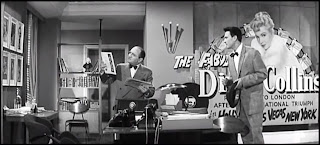“Lurid, tawdry, and sleazy ….”
Well, that sounds promising! The New York Times was clear in its appraisal of this 1962 adaptation of Nelson Algren’s novel but it doesn’t managed sustained instances of any of these descriptors.
It does have a stunning title sequence as a black cat prowls along accompanied by Elmer Bernstein and David Mack’s famous song (no relation to Lou’s Wild Side…) and, foretastes the film as it gets into a brief fight with a white cat... before carrying on its way with serene feline indifference…
 |
| On the road... |
 |
| Laurence Harvey |
The two sleep rough in road-side concrete pipes and hitch lifts on their way to New Orleans, Dove’s looking for his religion, a lost love, whilst Kitty’s looking for a good time and what-ever she can get. This includes Dove who repulses her advances – there’s only room in his heart for one girl.
 |
| Jane Fonda |
Teresina offers him work and he tells her off his quest to find his love, a sculptor named Hallie Gerard (Capucine) years after his loyalty to a dying father had split them apart as she headed for artistic fulfillment in arty Louisiana…
Dove works hard whilst Teresina helps him look for Hallie through ads in the local paper: she has a heart of gold and an eye for this new man but she respects his own desires. Nothing is forthcoming but, just as things seem helpless; someone provides a tip off…
Hallie is living with a strange bunch who just happen to run a cat house called the Doll House (see what they did there?), initially it appears as if she’s continuing with her sculpting career but she’s only doing a favour for the dominatrix who runs the House, Jo Courtney (Barbara Stanwyck who is the best actor on show by a street).
As the masculine abbreviation of her name suggests, Jo wears the trousers and dominates the men, from her crippled husband, mysteriously relegated to using a low-set cart instead of a wheelchair, to the muscle who maintain order in this curious, heartless culture.
And, unsurprising to modern audience but possibly shocking at the time, Jo seems to have an emotional attachment to Hallie, one that Dove will find very hard to break.
In truth, the film loses momentum at this point. Harvey does well with his accent but he wears it like a concrete coat and doesn’t emote very well as if he’s stuck on the “surly” setting. But the main problem is Capucine who’s beauty masks her acting ability. She also looks out of place in a bordello and one really can’t quite understand how she came to get stuck.
 |
| Barbara Stanwyck |
But the more obvious Hallie’s temptation to leave the more the iron fist of Jo starts to descend to block off her options.
Dove encounters Kitty at the Doll House; she has been rescued from imprisonment for vagrancy and owes Jo a lot. The elder woman sees a way to use her to blackmail Dove into leaving her girl alone. By accompanying Kitty across the state line, Dove has potentially committed a felony as she was underage…
 |
| Doll House shakedown... |
Everything comes together in a violent and confused ending which is very neatly tail-ended by the closing credits which feature our black cat strolling over a revealing piece of crumpled newspaper…
 |
| The final confrontation... |
 |
| Defiance... |
Overall Jane Fonda does well and, it has to be said, looks great, whilst Capucine looked good but acts awkwardly and inconsistently making the best of her casting but even so… Laurence Harvey does well with that accent and is believably intense – a very talented actor here not so well served by the script.
 |
| Capucine and Barbara Stanwyck |
Dusty verdict: Worth it for the opening sequences from the cat to wild Kitty! It falls off after that but the ending is never predictable. It’s available on DVD but I think I’ll stick with the VHS…







.png)








































+religion.jpg)
.jpg)

.jpg)